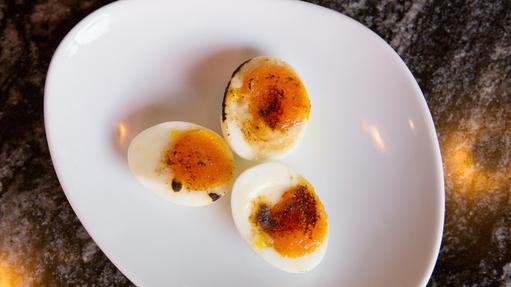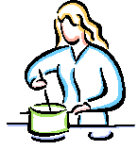 The Perfect Poach
The Perfect Poach
From: bonappetit.com
SERVES 2
1 cup distilled white vinegar
2 large eggs
Coarse sea salt (such as Maldon) and freshly ground black pepper
Pour 1/2 cup vinegar into each of 2 small bowls. Crack 1 egg into each bowl, taking care not to break yolk; let stand for 5 minutes.
Meanwhile, bring a medium saucepan of water to a boil over medium-high heat. Using a whisk, vigorously swirl water until a vortex forms in the center. Slip 1 egg with vinegar into vortex and continue to swirl water with whisk around edges of pan until it returns to a boil.
The egg white should wrap tightly around the yolk, forming an oval shape. As soon as water returns to a boil, reduce heat to medium and gently simmer egg, frequently swirling water, for 2 minutes. Using a slotted spoon, lift egg from water and use kitchen shears to trim any stray pieces of egg white.
Place egg on paper towels and gently blot; transfer egg to a bowl or plate. Repeat with remaining egg. (If poaching more than 2 eggs, repeat using fresh water.)
Season with salt and pepper.
DO AHEAD: Can be made 1 day ahead. Immediately transfer to a bowl of ice water and let cool. Using a slotted spoon, transfer to a plate. Cover; chill. Rewarm in a saucepan of simmering water for 1 minute.
TIP: Break the egg into a fine mesh sieve set over a bowl. The watery outer edge of the white will drain through, leaving the thicker white and yolk intact. Carefully swirl egg around strainer, using your finger to rub off any excess loose egg whites that drop through. Gently tip egg into water. Swirl gently with a wooden spoon for 10 seconds, just until egg begins to set; the white will firm up around the yolk, creating a smooth, compact package. Cook, swirling occasionally, until egg whites are fully set but yolks are still soft, about 4 minutes.
For more egg ideas, see bonappetit.com and Dukan Eggs

The Softest Scramble
From: bonappetit.com SERVES 4
Eggs
4 large eggs
2 tablespoons chilled unsalted butter, divided
Cayenne pepper
Kosher salt
Garnish (optional)
1/4 cup heavy cream, whipped to soft peaks
2-4 teaspoons caviar
Combine eggs and 1 1/2 Tbsp. butter in a small room-temperature saucepan and season lightly with cayenne and salt. Place over medium-low heat and cook, whisking gently and constantly while scraping bottom and sides of pan, until eggs are just thickened, creamy, and small curds begin to form, 3?4 minutes total. (If mixture begins to stick to pan while cooking, remove from heat; whisk gently for 30 seconds, then continue cooking over heat.) Remove from heat.
Add 1/2 Tbsp. butter; whisk until melted. Season with salt; divide among small bowls. Top with whipped cream and caviar, if desired.
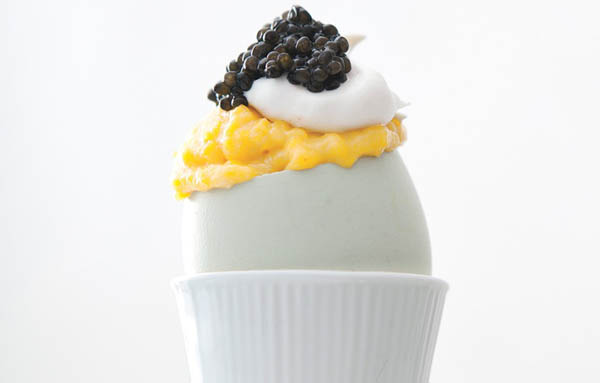
The Seven-Minute Boiled Egg
If what you want is a set white and a soft yolk, simple is best: the seven-minute egg. From Saveur
All you have to do is fill a saucepan with water (enough to cover a few large eggs), bring it to a boil, ease in the eggs (I lower them on a spoon), and set a timer for exactly seven minutes. (For medium eggs, try 6:30, or just straight-up six, if you live on the edge.)
If the water threatens to boil over, lower the heat, but keep it bubbling. If the egg cracks and a little white seeps out, don’t worry; it happens. Some people prick the shell with a pin before cooking, to let air escape.
When the timer goes off, drain the eggs immediately—this part is imperative—and run them under cold water until they’re cool to the touch
Company Eggs
From: bonappetit.com SERVES 6
2 tablespoons olive oil
1 small onion, thinly sliced
4 garlic cloves, finely chopped
Kosher salt, freshly ground pepper
2 bunches Swiss chard, thick center ribs and stems removed, leaves coarsely chopped (about 12 cups)
1/2 cup heavy cream
12 large eggs
2 ounces sharp white cheddar, grated (about 1/2 cup)
Preheat oven to 400°. Heat oil in a large skillet over medium heat. Add onion and garlic; season with salt and pepper. Cook, stirring occasionally, until onion is softened, 8-10 minutes.
Add chard to skillet by the handful, tossing to wilt between additions. Cook, tossing often, until tender, 8-10 minutes. Add cream and simmer until thickened and almost evaporated, 8-10 minutes; season with salt and pepper.
Spread chard mixture evenly in a 13x9x2-inch baking dish. Using the back of a spoon, make 12 small, evenly spaced divots in the chard mixture. Crack 1 egg into each divot. Season eggs with salt and pepper. Sprinkle cheese over.
Bake, rotating dish once, until egg whites are almost set and yolks are still runny, 15-18 minutes. Let stand 5 minutes before serving.
DO AHEAD: The chard and cream mixture can be made 1 day ahead. Cover and chill. Reheat before transferring to baking dish.
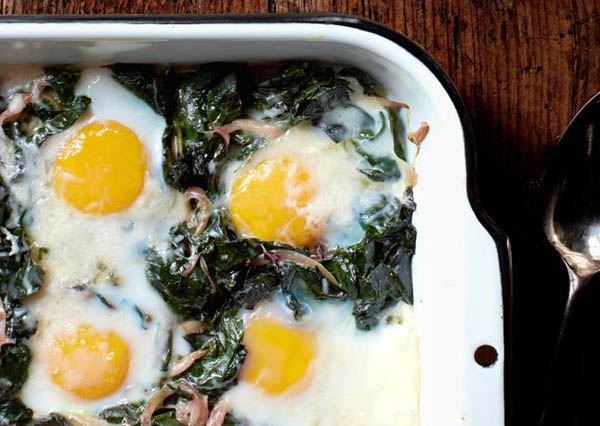
Horseradish Deviled Eggs
From: bonappetit.com SERVES 24
12 hard-boiled large eggs, peeled, halved lengthwise
1/3 cup mayonnaise
2 tablespoons prepared horseradish
2 teaspoons Champagne vinegar or white wine vinegar
2 teaspoons Dijon mustard
Kosher salt
1/4 cup fine fresh breadcrumbs
Preheat broiler. Mash egg yolks with mayonnaise, horseradish, vinegar, and mustard in a medium bowl until smooth. Season with salt and spoon back into egg whites. Sprinkle breadcrumbs over.
Place eggs on a broiler-proof baking sheet and broil, watching closely to prevent burning, until breadcrumbs are toasted, about 3 minutes.
DO AHEAD: Deviled eggs can be filled (not sprinkled with breadcrumbs) up to 6 hours ahead. Cover and chill.

Muffin Tin “Hard Boiled” Eggs
The eggs come out perfectly with the whites having a nicer texture, (never rubbery) a better flavor, and the best part….easier to peel! From yeswecoupon.com
Preheat oven to 325. Place one dozen eggs into a 12 count muffin tin. Bake 25 minutes. take eggs out of oven and let stand 5 minutes.
Place eggs in ice bath (or just run under cold water) until they are cooled through. Now your eggs are ready for peeling.
Baked Eggs in Avocado
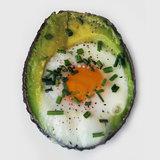 From: popsugar.com
From: popsugar.com
2 ripe avocados
4 fresh eggs
1/8 teaspoon pepper
1 tablespoon chopped chives
Preheat the oven to 425 degrees.
Slice the avocados in half, and take out the pit. Scoop out about two tablespoons of flesh from the center of the avocado, just enough so the egg will fit snugly in the center.
Place the avocados in a small baking dish. Do your best to make sure they fit tightly.
Crack an egg into each avocado half. Try your best to crack the yolk in first, then let the egg whites spill in to fill up the rest of the shell.
Place in the oven and bake for 15 to 20 minutes. Cooking time will depend on the size of your eggs and avocados. Just make sure the egg whites have enough time to set.
Remove from oven, then season with pepper, chives, and garnish of your choice. Enjoy!
Ludo Lefebvre's Omelet
From: bonappetit.com
Whisk eggs in a medium bowl until very, very well combined (there should be no strands of egg white remaining, but be careful not to incorporate too much air). To make sure eggs are really smooth, strain through a fine-mesh sieve into a small bowl.
Heat 1 Tbsp. butter in an 8" nonstick skillet over medium heat. Once the butter just begins to foam (don't let it sizzle), add eggs and season with fleur de sel and pepper. Using a rubber spatula, stir eggs very quickly and constantly in a figure-eight pattern while simultaneously moving the skillet around in a circular motion. Scrape down the sides of the skillet as you go to avoid dry bits in your omelet.
As soon as eggs begin to coagulate, which will take about 2 minutes, shake skillet to settle any uncooked egg. Keep stirring and moving pan in a circular motion until eggs are nearly cooked through on the bottom but still runny on top (or baveuse, as the French say), about 1 minute. Lift an edge of the omelet to check that it is holding together; the underside of the omelet should have taken on no color. Remove pan from heat and let sit 1 minute to help omelet release from skillet and maintain its smooth texture.
Spoon dollops of cheese across the center of the omelet, working perpendicular to the skillet's handle, setting you up to hold the handle with your left hand and flip the omelet onto your plate when the time comes.
Starting at the edge closest to the handle, immediately roll up omelet in 1½" intervals, using spatula, until halfway through. Add another 1 Tbsp. butter, then continue rolling up omelet and turn out onto a plate, seam side down.
Rub a little butter on top of omelet (to make it shiny) and sprinkle with fleur de sel and chives.
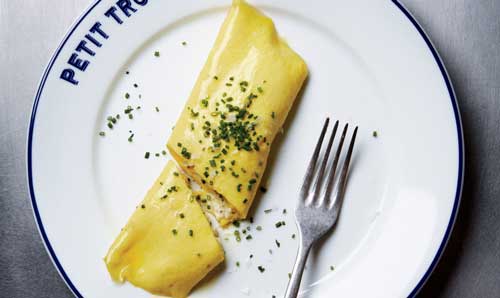
Egg Brulee
From: bonappetit.com
We’ve fried, scrambled, poached, baked, and boiled our way through dozens of eggs. (“Put an egg on it” is our unofficial motto around here.) But never before had we brûléed our eggs—until now. And it’s kind of blowing our minds.
Alvin Cailan of Eggslut in Los Angeles is the egg master behind this technique, which involves torching the tops of halved, soft-boiled eggs until the yolks become sweet, fudgy, and slightly caramelized, just like crème brûlée. Cailan shares his technique for the perfect brûlée:
Use Super Hot Water
Extremely hot water helps the egg release the shell from the whites for a cleaner peel, Cailan explains. Use water that’s come to a roaring boil to soft-boil the eggs first for 5½ minutes, then immediately dunk the eggs in an ice bath.
Crack from the Ends
For the cleanest peel, crack and begin peeling your eggs from one of the ends—rather than from the center—to reduce your chances of breaking the delicate whites. Give the eggs a dunk in the ice water bath as you go to get rid of any leftover bits of shell.
Make the Perfect Cut
For perfectly halved eggs, Cailan likes to use fishing wire. Imagine that you’re cutting cheese when you’re dragging the wire through the egg, he says.
Salt the Yolks
You have to sprinkle the tops of the egg halves with a little sugar to get that perfect caramelization. To balance out the flavor, Cailan salts the halves before sugaring them.
Go Low and Slow
Use a kitchen torch on low heat and wave it over the tops of the eggs until they start to bubble up and caramelize. There’s no substitute for a torch here, so go splurge!
